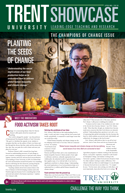“The first time I died was on October 31, 1982 at approximately 11:37 p.m.,” began award-winning writer, Joseph Boyden, to the more than 300 people crammed into Champlain College’s Great Hall on Wednesday, September 26 to hear this year’s Jack Matthews Fellow speak about the crisis facing aboriginal youth today. His talk, entitled “A Walk to Morning”, was organized into three “acts”, beginning with a deeply personal account of Mr. Boyden’s own struggles with depression and attempted suicide as an adolescent, a story that until recently, he admitted, he had only told to his closest friends and family.
“This is a very deeply personal thing I’m going to share with you today,” confessed Mr. Boyden. “It’s not an easy talk to give. I’ve reached the point in my life where I’ve been blessed with some success and I have been afforded an audience who I hope is still willing to listen to me. I don’t want to squander the opportunity to speak just because it would be easier not to. I’m one of eleven children after all and I know how easy it can be to simply fade into the background even when your gut is telling you to raise your voice. And so allow me to raise my voice this afternoon.”
What followed was a series of graphic vignettes juxtaposing the final moments of a gun shot victim dying in Mr. Boyden’s arms, with the first moments of his new son’s life – born in the back of a Buick Skylark inching it’s way through traffic towards the hospital. The narratives were ones of openings, rooted in the body: the eyes of a gunshot victim as they slowly glaze over, a bullet hole in the chest darkening the victim’s blue shirt, a birthing in the back seat of a car to the honking of horns and screams of pain. Blood and fear wove a common thread between the two stories with the immediacy of the physical body – its wounds and its strength – becoming the locus of both the pain and healing that, for Mr. Boyden, connects us to this life.
“I made a great mistake in attempting to do what I did,” confided Mr. Boyden. “I sometimes catch myself thinking, ‘What if I’d managed it? What if I had died?’ Just look at what I would have missed. And it’s not even the big stuff – it’s always the little things that catch me off guard: the weight of my wife’s foot on my own under the covers at night, the puppy smell of our dog, feeling the tug on my fishing rod when the pickerel strikes my lure, arguing with my son about finding a job. It’s these moments that make me thankful for my failure that night of my sixteenth birthday.”
Reflecting on the larger story of despair and suicide amongst First Nation youth, Mr. Boyden compared the crisis to an epidemic. “A death cult is taking root,” he maintained, “and it is spreading across northern reserves and native communities across Canada. It spreads more easily than H1N1. It’s been infecting northern communities for many years and it’s deadlier than any epidemic since the small pox.” With a suicide rate on the west coast of James Bay 100 times higher than the national average, the metaphor is apt.
For Mr. Boyden, the pain is the post-traumatic stress of watching a culture in destruction, and its solution is in reconnecting to communities, family, and most importantly, to the land. “An Anishinaabe medicine man that I know, when he speaks about the creation of residential schools he says that a door was open that never should have been unlocked,” recounted Mr. Boyden. “For westerners, this view might be compared to letting a sinister genie out of a bottle. One of the many evils that escaped out of that door according to the medicine man is the tremendously high suicide rate in our country.
Mr. Boyden’s writing embodies his philosophy of healing by anchoring itself in the physicality of the body and of the natural world. His hope is that by sharing that reality with others, through his talks, and through the camp he runs for native youth, that he will help create dialogue between what he calls “the three solitudes” and in so doing, create room for healing. “What I’m convinced of is this: the tension of the fast moving river through your paddle, the radiant heat in the moose’s rib cage as you reach your arm in to cut out its heart, the sound of Canada geese honking as they stretch their necks to the south, the tug of the pickerel as it takes your hook, the sickening grind of the outboard’s prop as it touches the emerged river rock, it’s these simple experiences that contain medicine strong enough to start some healing, to start closing that door.”
The Jack Matthews Fellowship is named after Mr. Jack Matthews, the founding director of the Trent International Program. A remarkable community leader, Mr. Matthews also founded Pearson United World College in B.C., was the first executive director of the Canadian Canoe Museum, and served as headmaster of Lakefield College School. These organizations have collaborated in honouring Mr. Matthews with the Jack Matthews Fellowship, which recognizes his profound commitment to the values of Canadian global citizenship.
Posted on Monday, October 1, 2012.


































